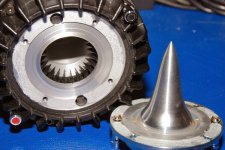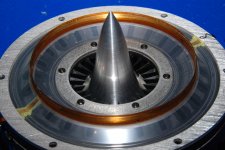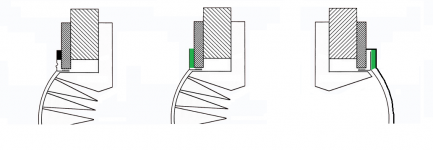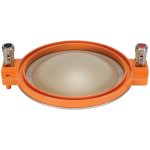That doesn't answer my question how to setup the simulation to obtain the actual impedances. But I think the slots can be regarded simply as wavegudies of their kind and use the same procedure. I only wonder if it depends on whether the other channels are driven at the same time or not. It should I guess.
To me getting a radially pulsating source is the holy grail to waveguide design. So if that was their motivation and if they succeded, which seems to be the case, based on the available measurements, then it is actually quite an achievement.Apart from a 3dB increase in power response, the added advantage of the KEF tangerine phaseplug seems questionable.
But hey, it looks cool so it'll probably sell 😉
Just look at the directivity index of the latest UniQ - https://www.audiosciencereview.com/forum/index.php?attachments/1588968486698-png.62530
Last edited:
That doesn't answer my question how to setup the simulation to obtain the actual impedances. But I think the slots can be regarded simply as wavegudies of their kind and use the same procedure. I only wonder if it depends on whether the other channels are driven at the same time or not. It should I guess.
Actually, the channels should be mutually coupled, i.e. pressure at the channels outputs effects each other acoustic loading. ABEC3 accounts this automatically if you consider each channel as the separate source. But for the correct simulation you should also consider thermoviscous losses that have profound effect in narrow channels, the picture below demonstrates the effect
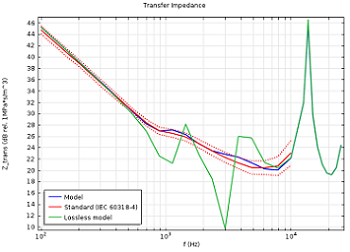
There is no way for direct account the thermoviscous losses in ABEC3, but you can do some approximation as was recently described by Joerg Panzer
http://pub.dega-akustik.de/ICA2019/data/articles/000394.pdf
Last edited:
Is there any commersial large CD horn available (like Klipsch K402) with 1,5 inch throat where you dont need a tweeter? Or what is the closest you get? Highpass should be At 600 Hz with a JBL 2450SL/2451 beryllium.
Fot the thermo effects you need comsol, but you can appoach the effect a bit by adding a little damping inside the channels.
And yes you can check every channel seperated and terminated with full absorption first.
I think this is good to do to isolate effects, the complete system is very complex and you ll have a hard time tuning thongs that way. A bit comparible to trying to tune a speakers and the roomnacoustics a the same time
One approach could be to have te channels exponentially expanding for better loading in the lower freqs, or you ccould also you continue the conical expansion of the horn right down to the phaseplug.
And yes you can check every channel seperated and terminated with full absorption first.
I think this is good to do to isolate effects, the complete system is very complex and you ll have a hard time tuning thongs that way. A bit comparible to trying to tune a speakers and the roomnacoustics a the same time
One approach could be to have te channels exponentially expanding for better loading in the lower freqs, or you ccould also you continue the conical expansion of the horn right down to the phaseplug.
P.S.
The picture from the paper "Compression Driver Simulation incl. Vibroacoustic, Viscothermal & Porous Acoustics" by Rene Christensen and Ulrik Skov.

The picture from the paper "Compression Driver Simulation incl. Vibroacoustic, Viscothermal & Porous Acoustics" by Rene Christensen and Ulrik Skov.

Last edited:
I would like to stick to ABEC for now, that's about my limit. Seems that when omitted, the results really get only better in the end. And it's actually a rather minor effect in the example above. So I think this can be ignored in the model without much trouble.
To me getting a radially pulsating source is the holy grail to waveguide design. So if that was their motivation and if they succeded, which seems to be the case, based on the available measurements, then it is actually quite an achievement.
Just look at the directivity index of the latest UniQ - https://www.audiosciencereview.com/forum/index.php?attachments/1588968486698-png.62530
Jack Oclee-Brown:
""Up to a frequency of 20kHz, the directivity index is almost identical to the version without the phase plug. However, between 20 and 30kHz, the tweeter with the radial-channel phase plug is less directional, although arguably the directivity index of the tweeter without the phase plug is slightly smoother."
and:
"Approximately 80 different permutations of the channel flare were evaluated before a combination of central plug shape, exit surface and flare function were found that resulted in satisfactory performance."
Also taking into account the manufacturing issues, one may wonder whether a minor performance gain > 20kHz is worth all the hassle.
Last edited:
OK, I haven't read that far. You would be right, then.
I'm astonished how well can a bare dome tweeter perform in a conical horn.
I'm astonished how well can a bare dome tweeter perform in a conical horn.
Is there any commersial large CD horn available (like Klipsch K402) with 1,5 inch throat where you dont need a tweeter? Or what is the closest you get? Highpass should be At 600 Hz with a JBL 2450SL/2451 beryllium.
Search for "JBL 2384 (+ mitchba)" and "JBL 2352".
The first is more similar to mabat's ATH4 and the latter is probably the best large format bi-radial horn ever produced by JBL. It's got a diffraction slot, but it's very small. Lot's of info on these horns to be found at lansingheritage and avsforum.
one may wonder whether a minor performance gain > 20kHz is worth all the hassle.
My cats will love it, but humans won't know the difference.
Search for "JBL 2384 (+ mitchba)" and "JBL 2352".
The first is more similar to mabat's ATH4 and the latter is probably the best large format bi-radial horn ever produced by JBL. It's got a diffraction slot, but it's very small. Lot's of info on these horns to be found at lansingheritage and avsforum.
I have 2384 today. It sounds very good. But it isnt loading good under 8-900 Hz.
You can see my system in post #3724
Hornlyd i et lite rom - Side 187
I had a huge Tractrix horn before and miss the huuuge deeep sound:
5 way horn & Acoustic Elegance
The problem was loobing. With 2384 i have point source from 800 Hz and all the way up. I have also tested with and without Fostex T500 and i prefer point source all the way up even if i lose som «air» over 10000 Hz.
It's part of the trade-off, or about the balance between directivity on the one hand and the characteristics of (multiple) Salmon horns on the other.
A modern (or "good" ~ Radian 835) 3" diaphragm/1.4" exit driver in a generously sized axisymmetric ATH4 (OS) 60-75° waveguide (±25cm depth), would probably constitute the best of both worlds.
Member POOH uses a hornloaded 2 way with Radian 835 + EV HR9040.
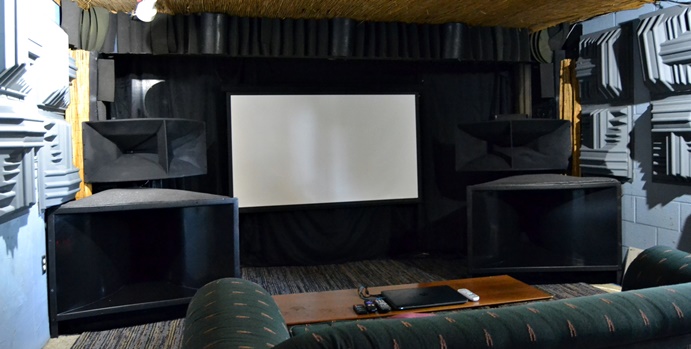
A modern (or "good" ~ Radian 835) 3" diaphragm/1.4" exit driver in a generously sized axisymmetric ATH4 (OS) 60-75° waveguide (±25cm depth), would probably constitute the best of both worlds.
Member POOH uses a hornloaded 2 way with Radian 835 + EV HR9040.
Last edited:
I have 2384 today. It sounds very good. But it isnt loading good under 8-900 Hz.
You can see my system in post #3724
Hornlyd i et lite rom - Side 187
I had a huge Tractrix horn before and miss the huuuge deeep sound:
5 way horn & Acoustic Elegance
The problem was loobing. With 2384 i have point source from 800 Hz and all the way up. I have also tested with and without Fostex T500 and i prefer point source all the way up even if i lose som «air» over 10000 Hz.
It seems quite a few guys in your country retreat from (Salmon-type) multiple hornsystems to more straightforward 2 ways (+ sub) with an increased focus on directivity.
The guy that goes by the moniker of Emokid takes the cake. He went from an ALE based multiple horn system including an Altec/GPA loaded bass array to a "modest" 2 way FLH system with 2x PD 15" (if I'm not mistaken) + TAD TD4003.
Last edited:
Maybe someone more informed about the mechanics involved could explain to me why a bending piece of metal (typically) is used as the surround all the time, instead of a ring of some more elastic material as illustrated (the green area). I thought about how to drive the compression cavity as uniformly as possible and this would be what I would try at least for the "convex drive". 

Attachments
It seems quite a few guys in your country retreat from (Salmon-type) multiple hornsystems to more straightforward 2 ways (+ sub) with an increased focus on directivity.
The guy that goes by the moniker of Emokid takes the cake. He went from an ALE based multiple horn system including an Altec/GPA loaded bass array to a "modest" 2 way FLH system with 2x PD 15" (if I'm not mistaken) + TAD TD4003.
Yes, and the sub is a folded 21 inch i think.
He is one of the three enthusiasts who develop the «modified K402» with a perfect throat to 1,5». Two verisons, one for TAD and another for JBL. One huge ca 112 cm and the ordinary ca 84 cm. The latter will probably be produced in a small series.
Look at the polar respons inn post 10513 under the text «sonogram storhornet», the large version. This is the best 600 Hz to 15000 Hz i have ever seen.
Loftet – superlang byggetrad - Side 526
I will probably have a pair (instead of my 2384) but are curios if someone knows if it is a horn who can match this.
It is a small group of enthusiast in Norway who have testet and measured a lot of horns and drivers in search for the best with beryllium drivers from TAD, JBL original, JBL with Truextent, Radian, the new 18Sound. JMLC 200/270/350/400. Traktrix 200. JBL 2360, 2384, etc. Big expensive wood radial horn etc. The goal is High pass 600 Hz and smooth, uncolored sound with constant directivity without a tweeter.
(Fostex T500, TAD 2001/2002/ET703/Ale has also been tested)
Last edited:
Maybe someone more informed about the mechanics involved could explain to me why a bending piece of metal (typically) is used as the surround all the time
Not "all the time", or in every instance
I assume you refer to the actual surround and not the metal support ring underneath?
Attachments
- Home
- Loudspeakers
- Multi-Way
- Acoustic Horn Design – The Easy Way (Ath4)
